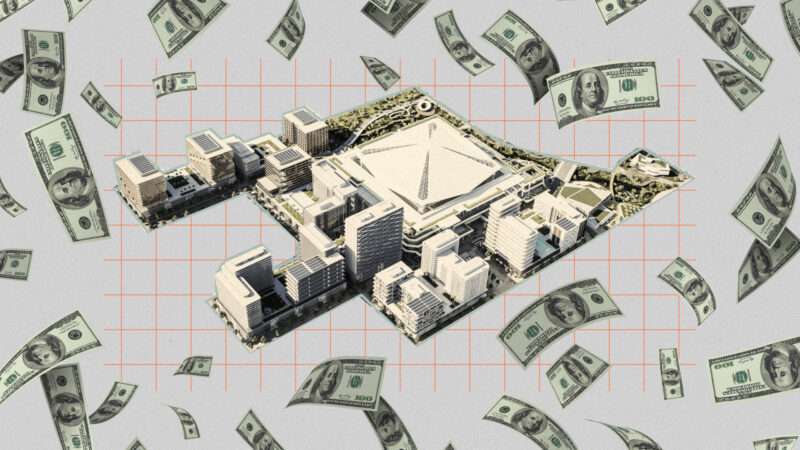
Despite being one of the most dynamic and competitive major league teams for the past 15 years, one thing has quite literally hung over the Tampa Bay Rays: Tropicana Field, the team's ugly and often mostly empty ballpark.
But that shouldn't justify asking taxpayers to foot half the bill for a new home.
Yet it looks like that's what will happen, now that Rays' owner Stuart Sternberg and local government officials have announced an agreement for a new, $1.3 billion stadium where the Rays hope to begin playing by 2028. Though the financial details of the deal remain a bit thin for now, the Tampa Bay Times reports that taxpayers in the city of St. Petersburg and those in Pinellas County (which includes the city) will split the $600 million public contribution to the project.
As Field of Schemes blogger Neil deMause notes, there are still a ton of questions to be answered—including the possibilities of backdoor subsidies like property tax breaks—which won't be fully addressed until the fine print of the deal is made public.
For now, here's what we do know: Plans for the new ballpark call for a fixed dome roof—similar to the one the Rays currently play home games under, though likely without the pesky catwalks that can cause havoc for fielders. Instead of a retractable roof, the stadium will include openable walls and windows that "bring the outside in," the team says.
That's a prudent decision that likely keeps the overall cost of the project down. Still, this is an exorbitantly expensive price tag—one that is likely to increase as it moves along—for a stadium that will seat only about 30,000 people when finished, making it the smallest in Major League Baseball. Ballpark Digest, a blog focused on baseball stadiums, describes the proposal as looking "more like a large arena than a traditional ballpark."
That's perhaps an acknowledgment of the Rays' real problem, which isn't the lack of a shiny new ballpark but an indifferent fan base that's never really embraced the team, despite its remarkable run of low-budget success. The team consistently ranks at or near the bottom of the American League in attendance. Only three times since its inaugural season of 1999 have the Rays drawn an average of over 20,000 fans per game.
Will a new ballpark change that? The Rays shouldn't have to look far for the answer. Their cross-state rivals, the Miami Marlins, similarly struggled with awful attendance figures for most of their first two decades as a major league franchise—despite winning two World Series in that span. The team's owners blamed their ugly, football-first ballpark for the low figures and eventually got a brand-new, baseball-only stadium funded with over $500 million in public cash.
Nothing has changed. Miami drew an average of 27,000 fans in their first season at Marlins Park but has ranked dead last in the National League for attendance in every season since then.
In Tampa, one of the oft-repeated reasons for the Rays' attendance struggles has been the location of Tropicana Field. "Most knowledgeable Tampa Bay residents and baseball fans know Tropicana Field is too far from the population center and the gridlock too tangled for enough fans to see the Rays on a daily basis," Michael Lortz wrote for FanGraphs, a sports blog, in 2017.
The Rays' solution to this problem is a head-scratching one: The new stadium will be built directly adjacent to the team's current home field.
Sports economist Daniel R. Epstein suggests that the Rays' strategy will be to price out fans who want to sit in the cheap seats. "By decreasing the number of seats in the stadium and keeping the park in the same general location, the Rays aren't trying to sell more tickets than they currently do—so they'll make up the difference by increasing the price," he writes in Forbes. "Improving the fan experience in and around the ballpark sounds great—for those who can afford it—but if they aren't interested in packing more fans into the park, they'll surely pursue wealthier ones instead."
So the Rays will trade a difficult-to-access, domed stadium for another difficult-to-access, domed stadium. Taxpayers will be out $600 million (and maybe more), fans who still want to see the team play in person will face higher ticket prices, and the team's attendance woes are likely to continue.
Other than all that, it sounds like a great deal.
The post Taxpayers Will Pay at Least $600 Million for Tampa Bay's New Baseball Stadium appeared first on Reason.com.







